
The Electorate of Cologne, sometimes referred to as Electoral Cologne, was an ecclesiastical principality of the Holy Roman Empire that existed from the 10th to the early 19th century. It consisted of the Hochstift—the temporal possessions—of the archbishop of Cologne, and was ruled by him in his capacity as prince-elector. There were only two other ecclesiastical prince-electors in the Empire: the Electorate of Mainz and the Electorate of Trier. The archbishop-elector of Cologne was also arch-chancellor of Italy and, as such, ranked second among all ecclesiastical and secular princes of the Empire, after the archbishop-elector of Mainz, and before that of Trier.
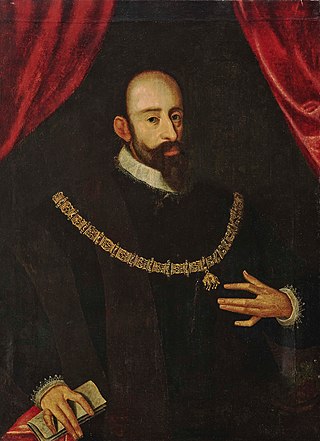
William V, called the Pious, was the duke of Bavaria from 1579 to 1597.
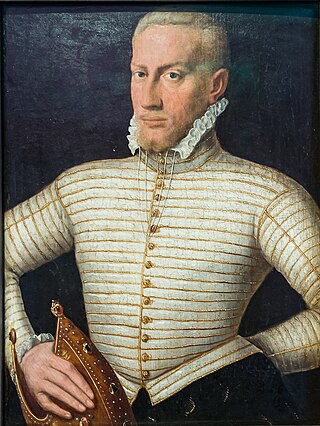
Gebhard Truchsess von Waldburg was the archbishop-elector of Cologne from 1577 to 1588. After pursuing an ecclesiastical career, he won a close election in the cathedral chapter of Cologne over Ernst of Bavaria. After his election, he fell in love with and later married Agnes von Mansfeld-Eisleben, a Protestant canoness at the Abbey of Gerresheim. His conversion to Calvinism and announcement of religious parity in the electorate triggered the Cologne War.

The Duchy of Westphalia was a historic territory in the Holy Roman Empire, which existed from 1102 to 1803. It was located in the greater region of Westphalia, originally one of the three main regions in the German stem duchy of Saxony and today part of the state of North Rhine-Westphalia. The duchy was held by the archbishop-electors of Cologne until its secularization in 1803.
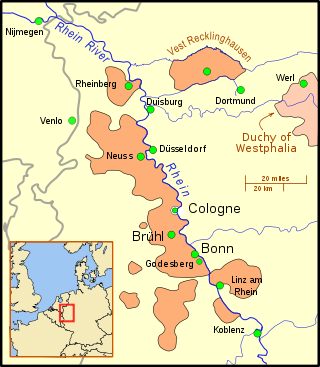
Vest Recklinghausen was an ecclesiastical territory in the Holy Roman Empire, located in the center of today's North Rhine-Westphalia. The rivers Emscher and Lippe formed the border with the County of Mark and Essen Abbey in the south, and to the Bishopric of Münster in the north. In the east, a fortification secured the border with Dortmund and in the west it was bordered by the Duchy of Cleves.

Wittelsbach-Hapsburg aristocrat Ernest of Bavaria was Prince-Elector-Archbishop of the Archbishopric of Cologne and, as such, Archchancellor of the Holy Roman Empire and Duke of Westphalia, from 1583 to 1612 as successor of the expelled Archbishop Gebhard Truchsess von Waldburg.

Salentin IX of Isenburg-Grenzau (c. 1532–1610) was the Archbishop-Elector of Cologne as "Salentin of Isenburg" from 1567 until 1577, the Bishop of Paderborn from 1574 until 1577, and the Count of Isenburg-Grenzau from 1577 to 1610.
Isenburg-Grenzau was the name of several states of the Holy Roman Empire, seated in the Lordship of Grenzau, in modern Rhineland-Palatinate, Germany. The first state called Isenburg-Grenzau existed 1158–1290; the second 1341–1439; and the third 1502–1664.
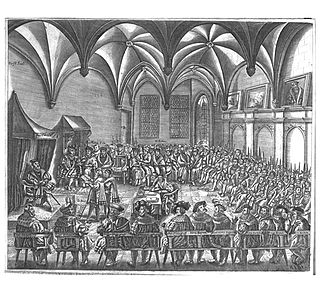
The reservatum ecclesiasticum was a provision of the Peace of Augsburg of 1555. It exempted ecclesiastical lands from the principle of cuius regio, eius religio, which the Peace established for all hereditary dynastic lands, such as those ruled by princes or dukes. Under this principle, the religion of the ruler would be the religion of the country and of its people, those being his possession by inheritance.
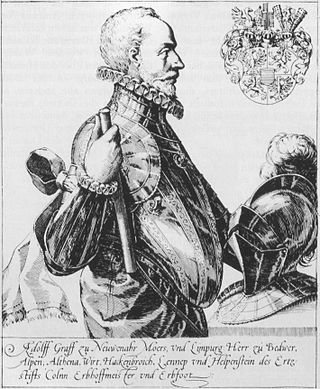
Adolf van Nieuwenaar, Count of Limburg and Moers was a statesman and soldier, who was stadtholder of Overijssel, Guelders and Utrecht for the States-General of the Netherlands during the Eighty Years' War.

The Cologne War was a conflict between Protestant and Catholic factions that devastated the Electorate of Cologne, a historical ecclesiastical principality of the Holy Roman Empire, within present-day North Rhine-Westphalia, in Germany. The war occurred within the context of the Protestant Reformation in Germany and the subsequent Counter-Reformation, and concurrently with the Dutch Revolt and the French Wars of Religion.

Agnes von Mansfeld-Eisleben (1551–1637) was Countess of Mansfeld and the daughter of Johann (Hans) Georg I, of Mansfeld Eisleben. She converted Gebhard, Seneschal of Waldburg, the Prince-Elector of Electorate of Cologne and archbishop of the Diocese of Cologne to the Protestant faith, leading to the Cologne War (1583–1588).

Maarten (Martin) Schenck van Nydeggen, was a noted military commander in the Netherlands.
Hermann Friedrich Cloedt was commander of the garrison at Neuss (Nuys), near Duisburg, in July 1586, when the city was destroyed by the Duke of Parma's Army of Flanders. He died in the defense of Neuss.
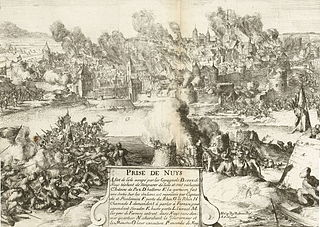
The Destruction of Neuss occurred in July 1586, during the Cologne War. Alexander Farnese, Duke of Parma's troops surrounded the city of Neuss, an important Protestant garrison in the Electorate of Cologne. After the city refused to capitulate, Parma's army reduced the city to rubble through a combination of artillery fire, destructive house-to-house fighting, and plundering; during the battle, a fire started that destroyed most of the rest of the city. Approximately 3,000 civilians died, out of a population of around 4,500, and the entire garrison was killed.

The Battle of Werl occurred between 3–8 March 1586, during a month-long campaign in the Duchy of Westphalia by mercenaries fighting for the Protestant (Calvinist) Archbishop-Prince Elector of Cologne, Gebhard Truchsess von Waldburg.

The Assault on Nijmegen occurred on the night of 10 August 1589, involving troops of the mercenary Martin Schenck von Nydeggen against the small garrison and some citizens at the city of Nijmegen.

The siege of Godesberg, 18 November – 17 December 1583, was the first major siege of the Cologne War (1583–1589). Seeking to wrest control of an important fortification, Bavarian and mercenary soldiers surrounded the Godesberg, and the village then of the same name, now Bad Godesberg, located at its foot. On top of the mountain sat a formidable fortress, similarly named Godesburg, built in the early 13th century during a contest over the election of two competing archbishops.
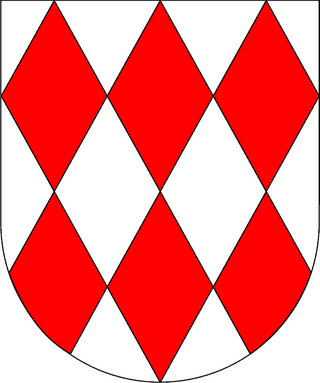
The House of Mansfeld was a princely German house, which took its name from the town of Mansfeld in the present-day state of Saxony-Anhalt. Mansfelds were archbishops, generals, supporters as well as opponents of Martin Luther, and Habsburg administrators.

Count Ernst von Isenburg-Grenzau was a Spanish general in the Thirty Years' War and the last representative of the Isenburg-Grenzau line.





















